The name of this pub recalls the barges which plied their trade on the Croydon Canal. Opened in 1809, the canal was replaced (in 1836) by the railway line, which was laid largely along the same course.
Framed illustrations and text about south Deptford.
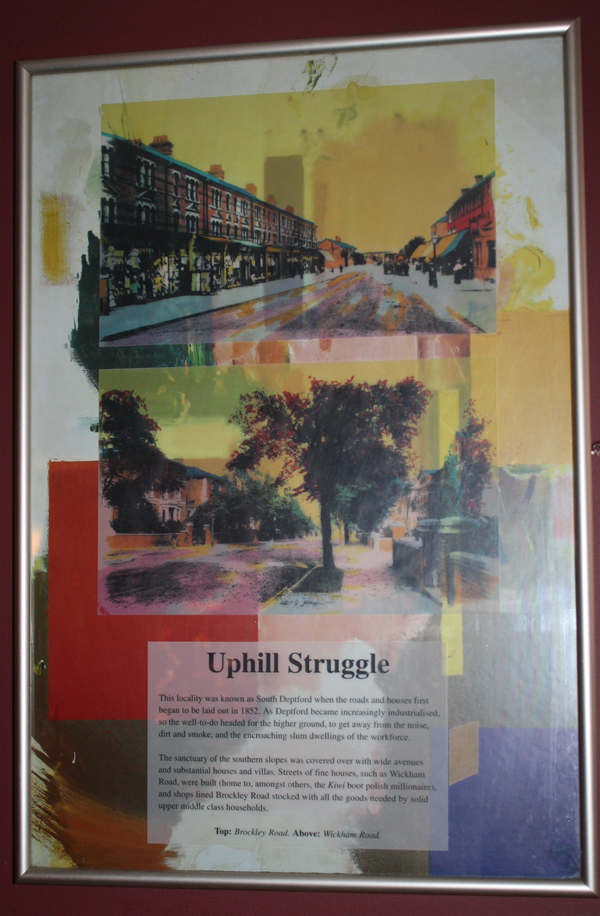
The text reads: This locality was known as South Deptford when the roads and houses first began to be laid out in 1852. As Deptford became increasingly industrialised, so the well-to-do headed for the higher ground, to get away from the noise, dirt and smoke, and the encroaching slum dwellings of the workforce.
The sanctuary of the southern slopes was covered over the wide avenues and substantial houses and villas. Streets of fine houses, such as Wickham Road, were built (home to, amongst others, the Kiwi boot polish millionaire), and shops lined Brockley Road stocked with all the goods needed by solid upper middle class households.
Top: Brockley Road
Above: Wickham Road.
Framed prints and text about Edgar Wallace.
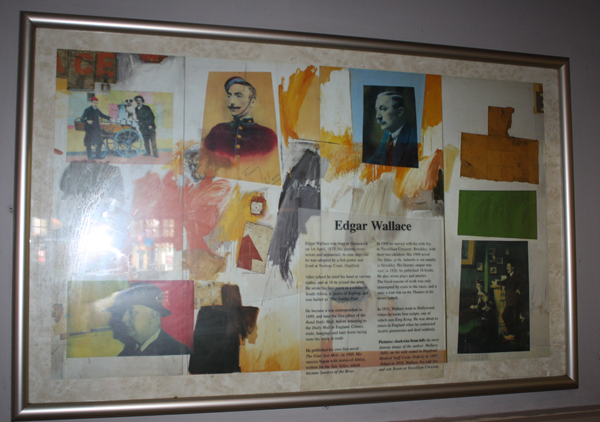
The text reads: Edgar Wallace was born in Greenwich on 1st April, 1875. His parents were actors and unmarried. At nine years old he was adopted by a fish porter and lived at Norway Court, Deptford.
After school he tried his hand at various trades, and at 18 he joined the army. He wrote his first poem as a soldier in South Africa, in praise of Kipling, and was hailed as ‘the soldier poet’.
He became a war correspondent in 1899, and later the first editor of the Rand Daily Mail, before returning to the Daily Mail in England. Crimes, trials, hangings and later horse racing were his stock trade.
He published his own first novel- The Four Joust Men- in 1905. His success began with stories of Africa, written for the Tale Teller, which became Sanders of the River.
In 1908 he moved with his wife Ivy to Tressillian Crescent, Brockley, with their two children. His 1909 novel The Duke of the Suburbs is set mainly in Brockley. His literary output was vast: in 1926, he published 18 books. He also wrote plays and articles. The fixed routine of work was only interrupted by visits to the races, and a once a year trip on the Thames in his motor launch.
In 1931, Wallace went to Hollywood where he wrote four scripts, one of which was King Kong. H was about to return to England when he contracted double pneumonia and dies suddenly.
Pictures: clockwise from left: the most famous image of the author: Walla, (left), on his milk round in Deptford: Medical Staff Corps Orderly in 1897; Edgar in 1914; Wallace, his wife Ivy and son Bryan at Tressillian Crescent.
Framed prints and text about work and entertainment in Brockley.
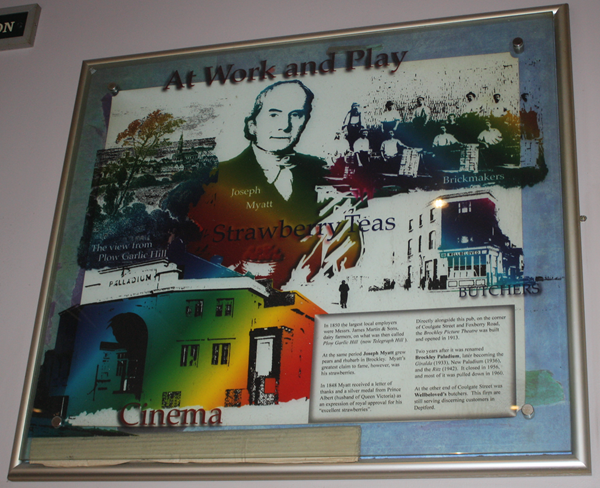
The text reads: In 1850 the largest local employers were Messrs, James Martin & Sons, dairy farmers on when was then called Plow Garlic Hill (now Telegraph Hill).
At the same period Joseph Myatt grew pears and rhubarb in Brockley. Myatt’s greatest claim to fame, however, was his strawberries.
In 1948 Myatt received a letter of thanks and a silver medal from Prince Albert (husband of Queen Victoria) as an expression of Royal approval for his “excellent strawberries”.
Directly alongside this pub, on the corner of Coulgate street and Foxberry Road, the Brockley Picture Theatre was built and opened in 1913.
Two years after it was renamed Brockley Paladium, later becoming the Giralda (1933), New Paladium (1936) and the Ritz (1942). It closed in 1956 and most of it was pulled down in 1960.
At the other end of Coulgate Street was Wellbeloved’s butcher. This firm are still serving discerning customers in Deptford
Framed prints and text about the railway and Croydon Canal.
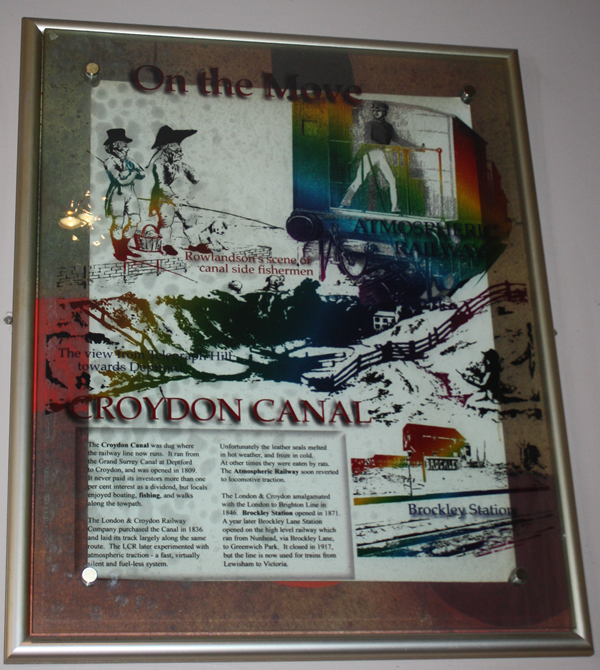
The text reads: The Croydon Canal was dug where the railway line now runs. It ran from the Grand Surrey Canal at Deptford to Croydon, and was opened in 809. It never paid its investors more than one per cent interest as a dividend, but local enjoyed boating, fishing, and walks along the towpath.
The London & Croydon Railway Company purchased the canal in 1836 and laid its track largely along the same route. The LCR later experimented with atmospheric traction- a fast, virtually silent and fuel-less system.
Unfortunately the leather seals melted in hot weather, and froze in cold. At other times they were eaten by rats. The Atmospheric Railway soon reverted to locomotive traction.
The London & Croydon amalgamated with the London to Brighton Line in 1846. Brockley Station opened in 1871 a year later Brockley Lane Station opened on the high level railway which ran from Nunhead, via Brockley Lane, to Greenwich Park. It closed in 1917, but the line is now used for trains from Lewisham to Victoria.
Framed prints and text about the Hilly Fields.
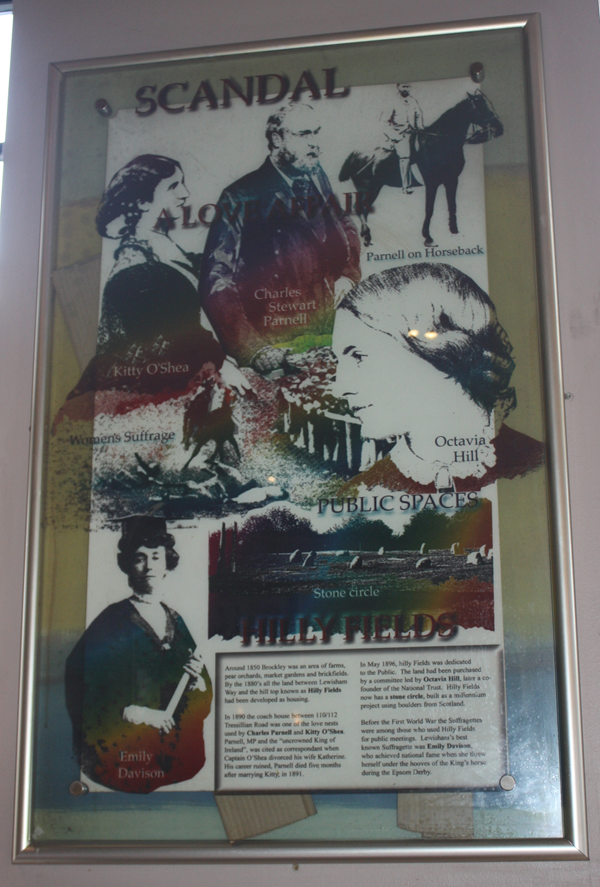
The text reads: Around 1850 Brockley was an area of farms, pear orchids, market gardens and brickfields. By the 1880’s all the land between Lewisham Way and the hill top known as Hilly Fields had been developed as housing.
In 1890 the coach house between 110/112 Tressillian Road was one of the love nests used by Charles Parnell and Kitty O’Shea. Parnell, MP and the “uncrowned King of Ireland”, was cited as correspondent when Captain O’Shea divorced his wife Katherine. His career ruined, Parnell died five month after marrying Kitty, in 1891
In May 1986, Hilly Fields was dedicated to the public. The land had been purchased by a committee led by Octavia Hill, later a co-founder of the National Trust. Hilly Fields now has a stone circle, built as a millennium project using boulders from Scotland.
Before the First World War the suffragettes were among those who used Hilly Fields for public meetings. Lewisham’s best known suffragette was Emily Davison who achieved national fame when she threw herself under the hooves of the King’s horse during the Epsom Derby.
A wall mural for Bob Marley, created by Dale Grimshaw.
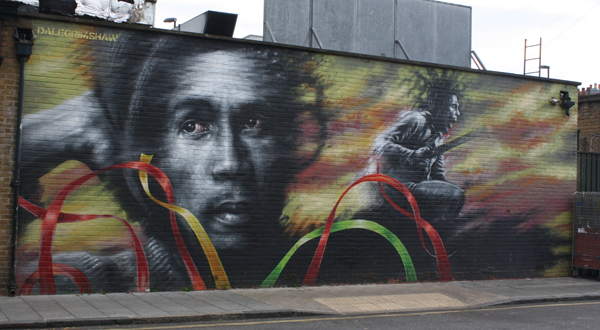
This wall art was originally on the building opposite The Brockley Barge. It was there for 49 years but was knocked down a few years ago. It was then commissioned to be redone on the pub’s wall, and is now considered a local landmark for the area.
External photograph of the building – main entrance.
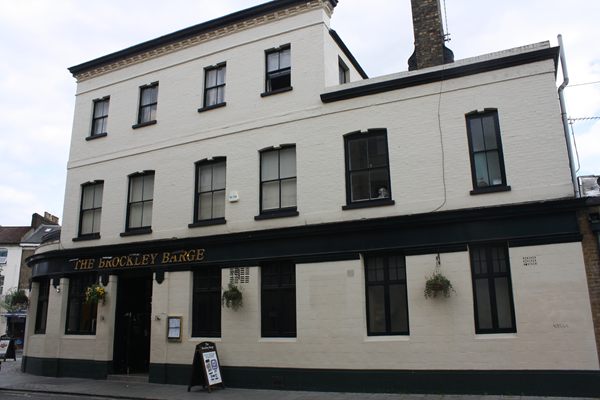
If you have information on the history of this pub, then we’d like you to share it with us. Please e-mail all information to: pubhistories@jdwetherspoon.co.uk